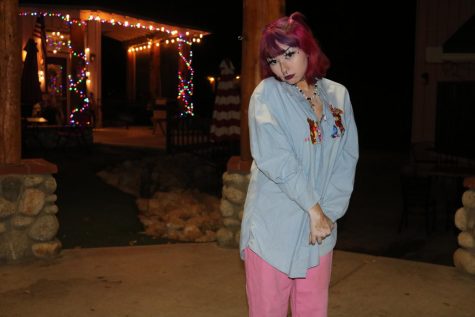How do brands and social media endorse fast fashion?
Fast fashion has become substantially popular through the years due to its affordability.
Janessa Cardenas ’23, Hailey Manning ‘24, Aryanna Ferguson ‘23
As fast fashion continues to manufacture clothing, not a lot of people understand the impact of their purchases and the consequences that come with it. Social media has become a big influence on the industry and continues to promote unsustainable brands.
Fast fashion has become substantially popular through the years due to its affordability. Most people tend to gravitate towards the cheaper route to most things, especially clothing. Causing people to shop at less expensive and less ethical brands.
How would students define fast fashion?
“I would define fast fashion as the result of overconsumption of fashion that is cheap and convenient as a result of new trends in today’s fashion. Buying clothes off of Shein to only wear once when whatever new micro-trend is in, only to throw away or donate it when the trend is over,” said Hailey Manning ‘24.
Shein, Romwe and AliExpress are just some of the fast fashion companies that teenagers gravitate towards because of social media and trends.
Big fast fashion corporations offer items that are frequently only made from nylon and polyester; therefore, the clothing will not survive long-term wear.
Because of this, students have to go back and keep buying from the same companies.
It becomes a pattern.
Students feel the need to stay in trend with their attire, so they go the affordable and fastest route rather than shop at more sustainable clothing stores.
“People tend to shop fast fashion because it is substantially more affordable than ethical brands,” said Lauren Rabago ‘23, who is a member of the Fashion Club at the high school.
Why would students shop on fast fashion websites?

Janessa Cardenas ’23 says fast fashion is a continuous cycle.
“Students shop in fast fashion because of the influence of social media and micro-trends. Micro-trends are cheap, stylish fashion items that are designed to last until the end of the current year or season,” said Janessa Cardenas ‘23. “Teens take advantage of fast fashion by buying clothes for the new micro-trends. Then when the micro-trend comes to an end, they get rid of the old clothing and buy the new trendiest clothing. It cycles.”
Students of this generation tend to rely on micro-trends that usually start through social media apps like Pinterest, TikTok, Instagram, and more. Micro-trends have a big impact on the fashion industry. After the next year or so since their purchase, the pieces become “out of style” and basically become useless to the owner, which results in wasted clothing that ends up burned or in landfills.
Social media: How it endorses fast fashion through promotions and advertising
“I do believe that social media plays a part in fast fashion,” said Aryanna Ferguson ‘23. “Influencers have a lot to do with marketing. They support sites like Fashion Nova and Shein to their followers, whose main demographic is teenagers and young adults with little spending money.”
Sometimes, social media influencers end up advertising unethical companies and promoting fast fashion products. So that consumers end up buying and sharing the products.
Only then do the companies get more profit and recognition. On Instagram, Snapchat, and Google Web Stories, advertisements for unsustainable clothing brands are marketed to students, bombarding them with constant promotions and advertisements.
“Media plays a large role in fast fashion,” Manning said. “By constantly circulating between new trends and pushing whatever is new and ‘in’ for the week through advertisements and social media influencers.”
Manning believes this influences the majority of, if not all, micro-trends to push fast fashion.
She said, “Fast fashion plays a large role in not only mine, but anyone’s perception of what’s ‘in-style.’ You’re constantly seeing different trends go in and out on your screen and equating it to real life and assuming others must assume the same thing.”
What are the consequences of fast fashion?
“From bulks of waste in landfills and not paying their workers, Fast fashion also impacts the environment through carbon emissions. The industry is responsible for 10% of global CO2 emissions each year,” Rabago said.
Child labor and harsh working conditions towards their workers are just a few things that go on behind the scenes in sweatshops.
Sweatshops are factories that mass produce clothing and employees work exceptionally long hours for very low wages and frequently in illegal conditions. Workers are treated poorly and in terrible conditions. Some of the worse conditions include being forced to work up to 72 hours straight, without break or sleep. Complaining would result in abuse whether that would be verbal or physical.
On an estimate, 250 million children worldwide within the ages of 5 to 14 are forced to work in sweatshops in third world countries unwillingly.
The fast fashion industry is the second largest polluting industry in the world. As the industry grows, so does environmental damage.
“Cloth composed of both synthetic fibers and non-synthetic fibers is very difficult and expensive to recycle. Most of it still ends up in landfills. The best solution is to cut down on our consumption,” said Lauren Cruz, who teaches biology at the high school.
Big corporations use synthetic fibers which are biodegradable and can take up to 200 years to decompose.
As of March 2021, it is estimated that the average American throws away about 81 pounds of clothes every year.
In foreign countries that mass produce fast fashion, noxious wastewater are dumped into rivers that contain substances such as lead, mercury, and arsenic. Not only are these heavy metals horrible for the environment and marine life, but also the health of people that live by riverbanks.
The fashion industry is a major contributor to water consumption. Freshwater is used for dyeing and major components for all of our clothes. It can take up to 200 tons of freshwater per ton of dyed fabric.
“Speaking of water use, recycled synthetic material is usually very random in color,” said Cruz. “So even if it is recycled, it takes a lot of chemicals and water to get it back into a uniform color.”
There are some solutions and alternatives to these issues, but it depends on individuals and corporations and the willingness to change and overcome them.
Why does fast fashion continue to produce when there are more quality clothes in the market?
“Big fast fashion corporations do not care about ethics or morals. Corporations primarily care about money. They couldn’t care less about their workers making the clothing,” Ferguson said. “Fast fashion has been connected to horrible working conditions for decades. Most of these clothes are produced in foreign countries [and] in sweatshops made by people working for a barely livable salary.”
Fast fashion corporations have a reputation for underpaying their workers. Meanwhile, they accumulate tons of revenue from consumers all around the globe.
“I think it has everything to do with profit. Fast fashion provides a way to constantly sell something new. It has nothing to do with whether the clothing will last because that doesn’t make them as much money as fast fashion would,” Manning said.
What are some solutions to fast fashion and what do we do to help? Alternatives?
“We could all start with simply buying less. And when it comes to buying clothing, buy from sustainable brands or buy in a sustainable way, such as buying secondhand. Buying from sustainable brands leads to buying less because those pieces will last longer than pieces from fast fashion sites. Buying second hand is giving a second chance at life to a piece that otherwise might have ended up in a landfill. Older second hand-pieces tend to be of higher quality as well,” Ferguson said.
If one does buy from a store, the recommendation is to buy from clothing brands that are transparent.
“This doesn’t mean designer,” Cruz said. “It means buying from brands that tell you where they get their materials and what they pay their workers. There are only a few brands that currently do this, but more would if consumers demanded it.”
Apparel shops such as Known Supply, LACAUSA, and Equihua are all very good examples of businesses that enclose the ethics and the background of the workers to its brands.
Most sustainable brands are more expensive and tend to have higher prices than others, such as ethical manufacturing, seeing and understanding the makers that produce your clothing, as well as being aware of the background of your pieces of clothing and where it comes from.
Secondhand stores, such as the neighborhood Goodwill or Angel View, can be a great outlet to avoid contributing towards fast fashion and its effects. Even now with modern technology, thrift stores can now be founded online through apps such as Depop, Poshmark and Mercari. Students can even upload items themselves with the click of a few buttons, which can be a much more convenient and efficient way of selling personal items such as up-cycled clothing, hand-me-downs, and more.
“Things you can do to minimize your contribution is hosting a clothing swap between you and your friends. Just bring a bag of clothes you don’t want and have your friends do the same, then meet up and pick out the clothes you want,” Rabago said. “Whatever you do after is optional, but after we take what is left of the clothes to the local goodwill. Up-cycling is a good way to repurpose your old clothing as well.”
How can we support small businesses?
There are a ton of alternatives to fast fashion, such as shopping at smaller and more sustainable brands. Local businesses produce clothes in ways that are not only better for your wardrobe, but also for the environment.

Aryanna Ferguson ’23 believes fast fashion companies care more about money than ethics.
There are quite a few small local businesses in the Coachella Valley, such as Skeleton USA. Established in 2017, the founder of Skeleton USA, Elijah Morales, provides a contemporary clothing brand with high morals and standards in its most genuine form. Unlike most fast fashion brands, Skeleton USA comes up with its own designs and manufactures its clothing independently. In fact, the brand rejects fast fashion and promotes and embraces authenticity at its core.
“It is frustrating when I see companies steal ideas from independently owned clothing brands because typically speaking these companies are not original or creative. Their sole purpose is to take ideas and concepts from the fashion industry, whether that be independent-owned companies or big fashion corporations, and make those items into cheap products that they can mass produce. It’s a sick game,” Morales said.
Bigger corporations tend to copy smaller brands to collect profit. Not only that, but it appeals to consumerism and the consistent demand for new clothes for cheap prices. Even if it’s not the legitimate item, consumers will still buy it knowing it’s a knock-off due to its affordability.
“Everyone loves cheap, but they don’t see the full picture,” Morales said.
What can you do to help?
Typically speaking, since the late 1990s and 2000s, when low-cost fashion had reached a peak they’ve had a pretty successful response towards their consumers. Fast fashion might be difficult to get rid of, but that doesn’t mean we shouldn’t avoid it.
“Try buying from independently owned clothing companies. Buy better quality items even if they cost more because typically speaking they will last you longer. Lastly, buy fewer items from fast fashion companies, so they won’t have an incentive to produce more,” Morales said.

Laly Bautista is a junior and a first-year journalist. She adores fashion, art, and is also a music enthusiast, who watches too many episodes of “Kitchen Nightmares."









Travis ♦ Jan 3, 2022 at 1:16 pm
Love it!!! ;-)
Arianna ♦ Dec 22, 2021 at 5:24 pm
Amazing article! Well said!!
Great job Laly fashionista queen!!!
Avery Webb ♦ Dec 20, 2021 at 7:18 pm
Great article!